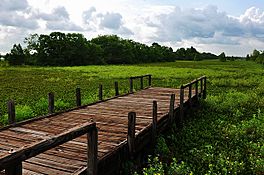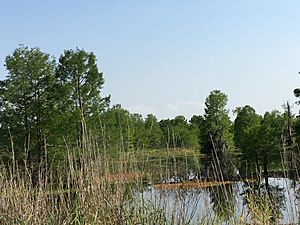Sheldon Lake facts for kids
Quick facts for kids Sheldon Lake |
|
|---|---|

Sheldon Reservoir Sea of Grass
|
|
| Location | Harris County, Texas |
| Coordinates | 29°52.22′N 95°10.37′W / 29.87033°N 95.17283°W |
| Type | reservoir |
| Primary inflows | Carpenters Bayou |
| Primary outflows | Carpenters Bayou |
| Basin countries | United States |
| Surface area | 1,230 acres (500 ha) |
| Max. depth | 10 ft (3.0 m) |
| Water volume | 5,354 acre⋅ft (0.006604 km3) |
| Surface elevation | 47 ft (14 m) |
Sheldon Lake is a large lake in Texas. It is about 16 miles (26 km) northeast of downtown Houston. This lake was created by building a dam on Carpenters Bayou. It is part of the larger San Jacinto River system.
Contents
History of Sheldon Lake
Sheldon Lake was built in 1943. The United States government needed fresh water for shipbuilding and shipping. This was important during World War II. After the war, the city of Houston managed the lake.
In 1952, the city sold the lake to the Texas Parks and Wildlife Department. They wanted to use it as a safe place for water birds. It also became a public fishing spot. In 1984, the land around the lake became the Sheldon State Wildlife Management Area.
Fish and Plants of Sheldon Lake
Sheldon Lake has many types of fish. These fish were added to make fishing better for visitors. You can find different kinds of fish here, including:
- Catfish
- Largemouth bass
- Crappie
- Bluegill
- Other sunfish
Fun Things to Do at Sheldon Lake
Sheldon Lake is a great place for outdoor activities. Many people enjoy birdwatching and fishing here. The park has four main types of natural areas:
- Woods near the water
- Restored coastal prairie (grassy lands)
- Open water and marsh areas of the lake
- Cypress swamps
These areas show what the Upper Texas Coast is like.
Birdwatching at Sheldon Lake
Sheldon Lake is a fantastic spot for birdwatching. Experts have found 249 different bird species here. In the spring, you can see over 200 kinds of birds.
Texas's largest group of water birds lives on the lake's islands. You can watch and listen to these birds from the west side of the lake. This bird colony is growing! Each year, over 2,200 nests are built by birds like:
Other birds like the purple gallinule and least bittern also raise their young here. In spring, over 22 types of birds that travel long distances also visit.
Winter is another good time for birdwatching. Over 160 bird species can be seen in winter. Some special winter birds include:
- Ash-throated flycatchers
- Vermilion flycatchers
- Fish crows
- Le Conte's sparrows
- Grasshopper sparrows
- American bitterns
- Canvasbacks
- Ross's goose
You can find an updated list of birds and tips for birdwatching at Friends of Sheldon Lake SP.




